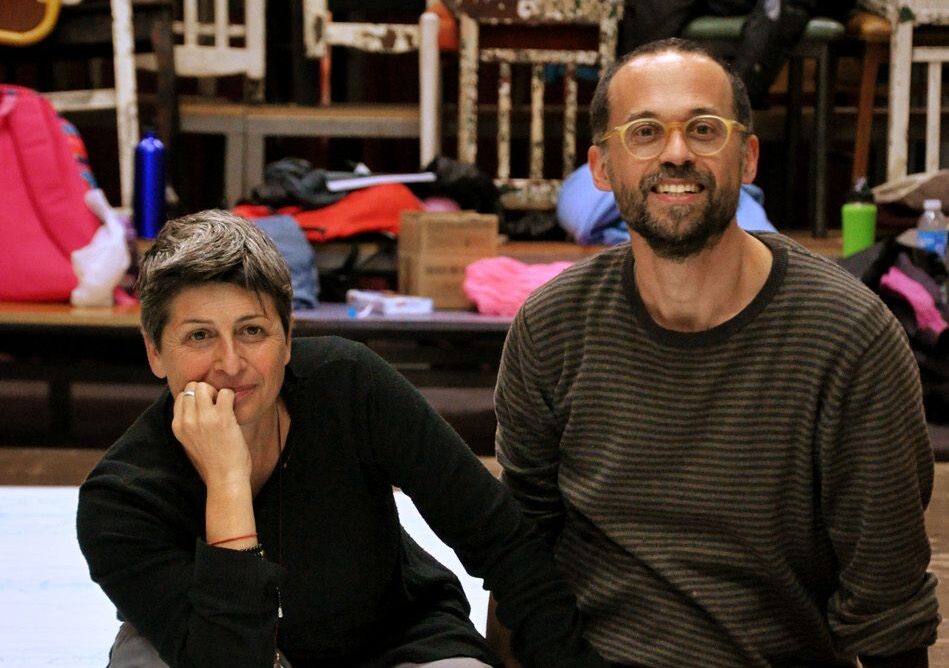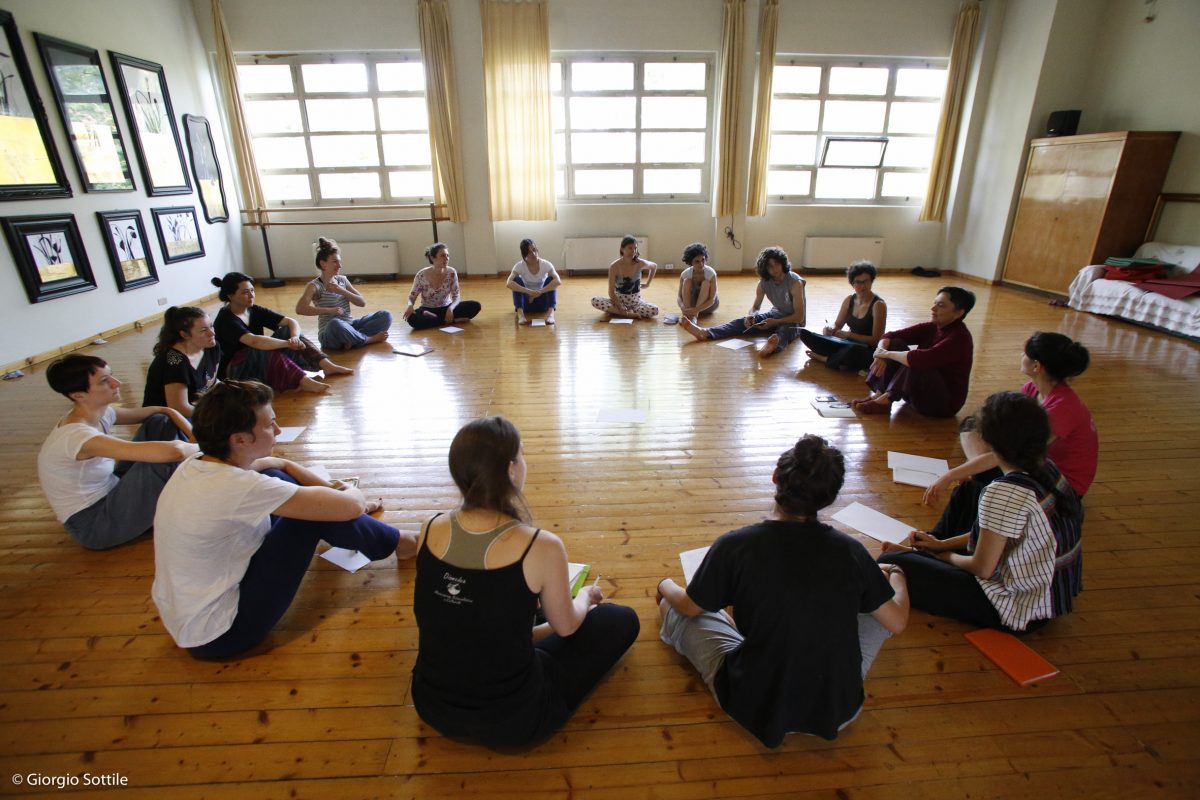29 Novembre
6:00 pm - 8:30 pm
BALLROOM

Luogo
- Lavanderia a Vapore
- Collegno (TO)
Agenda
Chi siamo
Reti
Lo spazio
Blog
News







è libertà di essere chi voglio quando nessun* mi vede
è percepire il mio corpo in modo totalmente diverso,
stare nella scatola è sentirmi,
spiare il mondo,
è protezione dai giudizi, dalla paura, dalle aspettative,
allo stesso tempo è intrappolamento, è stare chiuso con me stess*

Chi ha detto che mentre la mano scivola sul foglio il resto del corpo deve rimanere a dormire? Si può lasciare il segno con tutto il corpo: rotolando, saltando, ridendo, muovendo l’aria. Si può trovare il proprio posto reinventando lo spazio. Segni mossi è un progetto di movimento e segno grafico per bambini e adulti di Alessandro Lumare e Simona Lobefaro. Un’occasione per sperimentare insieme l’unità tra due linguaggi solitamente considerati separati.
Segni mossi, to move to mark!
Who said that while the hand slides on the paper the rest of the body should remain to sleep? You can make your mark with the whole body: rolling, jumping, laughing, moving the air. You can find your place by reinventing the space. Segni mossi is a movement and graphic sign project for children and adults by Alessandro Lumare and Simona Lobefaro. An opportunity to experience together the unity between two languages usually considered separate.



OONAGH DUCKWORTH – Inglese ma di base a Bruxelles, è direttrice del programma annuale della Springback Academy. Nel suo periodo di attività come freelance, è stata danzatrice, giornalista culturale e programmatrice, lavorando con enti come il Centre Pompidou di Parigi, The Place Theatre a Londra e Les Brigittines a Bruxelles, coltivando allo stesso tempo progetti indipendenti. Come giornalista ha collaborato con testate quali «The Guardian», «Elle Magazine», «The Evening Standard», «City Limits» e «Time Out», nonché con numerose pubblicazioni belga in lingua inglese. Collabora spesso in qualità di editor per testi in lingua inglese per compagnie belga di danza.
SANJOY ROY – Dal 2002 collabora occupandosi di danza con la testata «The Guardian» e ha fondato nel 2018 «Springback Magazine», lanciato dal network europeo Aerowaves; collabora con molte altre pubblicazioni quali «New York Times», «Dance Gazette», «Dancing Times» e «Dance International». Ha concepito e ideato lo script per l’animazione Planet Dance: a visitor’s guide to contemporary dance (The Place, Londra) e ha scritto il noto Step by Step Guides to Dance (Guardian, 2008-11). L’archivio delle sue attività di scrittura è disponibile online sul sanjoyroy.net.
MARTA PASTORINO – Scrittrice e formatrice. Per oltre vent’anni la sua ricerca si è divisa tra scrittura narrativa, arti performative e pratiche di cura e consapevolezza. È Docente Senior nella Didattica della Scuola Holden in Academy, in cui insegna una disciplina chiamata Intensità: come trasmettere la propria energia e fisicità nella scrittura. Pubblica articoli, recensioni e racconti su quotidiani, antologie e riviste. Editi, si trovano i romanzi Effetti collaterali (2006) per Meridiano Zero e Il Primo gesto per Mondadori (2013).
ph. Andrea Macchia per Ricerca X






L’azione del guardare, all’interno di un luogo in cui poterlo fare al meglio. Questo ci suggerisce, fin dalle sue origini, la parola teatro. Lo scopriamo, soffermandoci sull’etimologia del termine (proveniente dal verbo greco θεάομαι, “guardare, considerare”). Ed è proprio questa minuscola riflessione ad aver aperto in noi i più vari interrogativi: è ancora questa la funzione del teatro? Guardare ed essere guardati? Si trasformerà nel tempo? E soprattutto, se chiamiamo in causa un pubblico giovane, come cambia per loro l’idea e il concetto di pubblico, performer e regista? Il gioco proposto all’interno del laboratorio diviene espediente per smarrire e successivamente appropriarsi di una connessione attualizzata con lo spazio teatrale. (A.P. e V.R.)


Lavanderia a Vapore
We firmly believe that the internet should be available and accessible to anyone, and are committed to providing a website that is accessible to the widest possible audience, regardless of circumstance and ability.
To fulfill this, we aim to adhere as strictly as possible to the World Wide Web Consortium’s (W3C) Web Content Accessibility Guidelines 2.1 (WCAG 2.1) at the AA level. These guidelines explain how to make web content accessible to people with a wide array of disabilities. Complying with those guidelines helps us ensure that the website is accessible to all people: blind people, people with motor impairments, visual impairment, cognitive disabilities, and more.
This website utilizes various technologies that are meant to make it as accessible as possible at all times. We utilize an accessibility interface that allows persons with specific disabilities to adjust the website’s UI (user interface) and design it to their personal needs.
Additionally, the website utilizes an AI-based application that runs in the background and optimizes its accessibility level constantly. This application remediates the website’s HTML, adapts Its functionality and behavior for screen-readers used by the blind users, and for keyboard functions used by individuals with motor impairments.
If you’ve found a malfunction or have ideas for improvement, we’ll be happy to hear from you. You can reach out to the website’s operators by using the following email
Our website implements the ARIA attributes (Accessible Rich Internet Applications) technique, alongside various different behavioral changes, to ensure blind users visiting with screen-readers are able to read, comprehend, and enjoy the website’s functions. As soon as a user with a screen-reader enters your site, they immediately receive a prompt to enter the Screen-Reader Profile so they can browse and operate your site effectively. Here’s how our website covers some of the most important screen-reader requirements, alongside console screenshots of code examples:
Screen-reader optimization: we run a background process that learns the website’s components from top to bottom, to ensure ongoing compliance even when updating the website. In this process, we provide screen-readers with meaningful data using the ARIA set of attributes. For example, we provide accurate form labels; descriptions for actionable icons (social media icons, search icons, cart icons, etc.); validation guidance for form inputs; element roles such as buttons, menus, modal dialogues (popups), and others. Additionally, the background process scans all the website’s images and provides an accurate and meaningful image-object-recognition-based description as an ALT (alternate text) tag for images that are not described. It will also extract texts that are embedded within the image, using an OCR (optical character recognition) technology. To turn on screen-reader adjustments at any time, users need only to press the Alt+1 keyboard combination. Screen-reader users also get automatic announcements to turn the Screen-reader mode on as soon as they enter the website.
These adjustments are compatible with all popular screen readers, including JAWS and NVDA.
Keyboard navigation optimization: The background process also adjusts the website’s HTML, and adds various behaviors using JavaScript code to make the website operable by the keyboard. This includes the ability to navigate the website using the Tab and Shift+Tab keys, operate dropdowns with the arrow keys, close them with Esc, trigger buttons and links using the Enter key, navigate between radio and checkbox elements using the arrow keys, and fill them in with the Spacebar or Enter key.Additionally, keyboard users will find quick-navigation and content-skip menus, available at any time by clicking Alt+1, or as the first elements of the site while navigating with the keyboard. The background process also handles triggered popups by moving the keyboard focus towards them as soon as they appear, and not allow the focus drift outside it.
Users can also use shortcuts such as “M” (menus), “H” (headings), “F” (forms), “B” (buttons), and “G” (graphics) to jump to specific elements.
We aim to support the widest array of browsers and assistive technologies as possible, so our users can choose the best fitting tools for them, with as few limitations as possible. Therefore, we have worked very hard to be able to support all major systems that comprise over 95% of the user market share including Google Chrome, Mozilla Firefox, Apple Safari, Opera and Microsoft Edge, JAWS and NVDA (screen readers).
Despite our very best efforts to allow anybody to adjust the website to their needs. There may still be pages or sections that are not fully accessible, are in the process of becoming accessible, or are lacking an adequate technological solution to make them accessible. Still, we are continually improving our accessibility, adding, updating and improving its options and features, and developing and adopting new technologies. All this is meant to reach the optimal level of accessibility, following technological advancements. For any assistance, please reach out to
